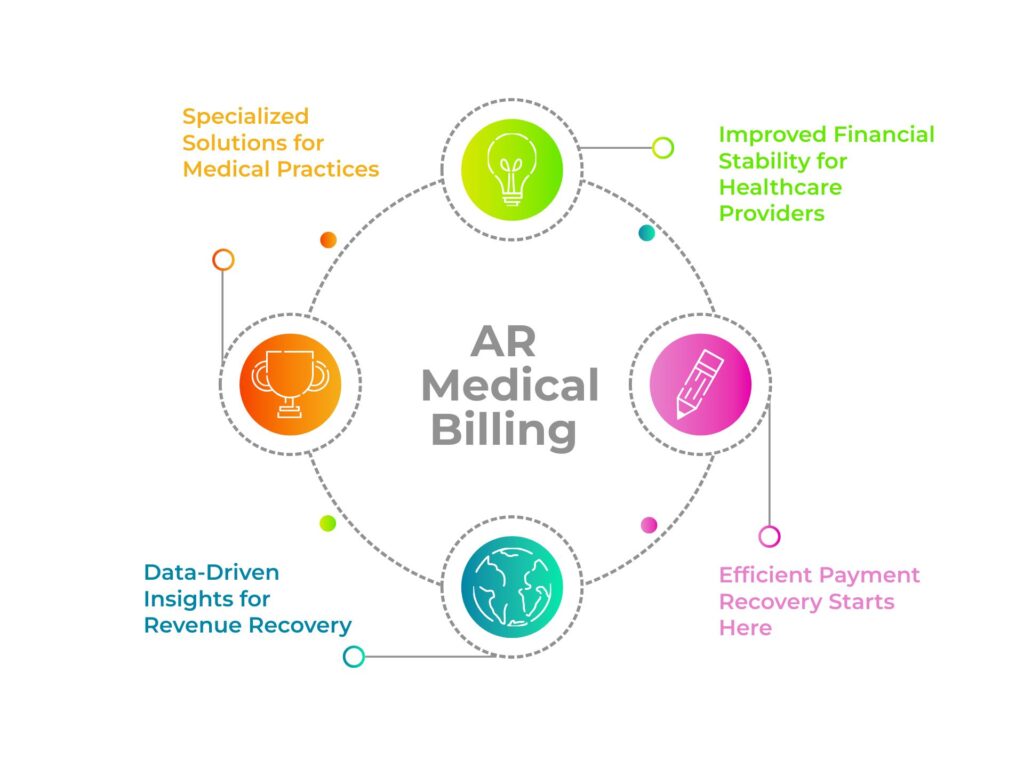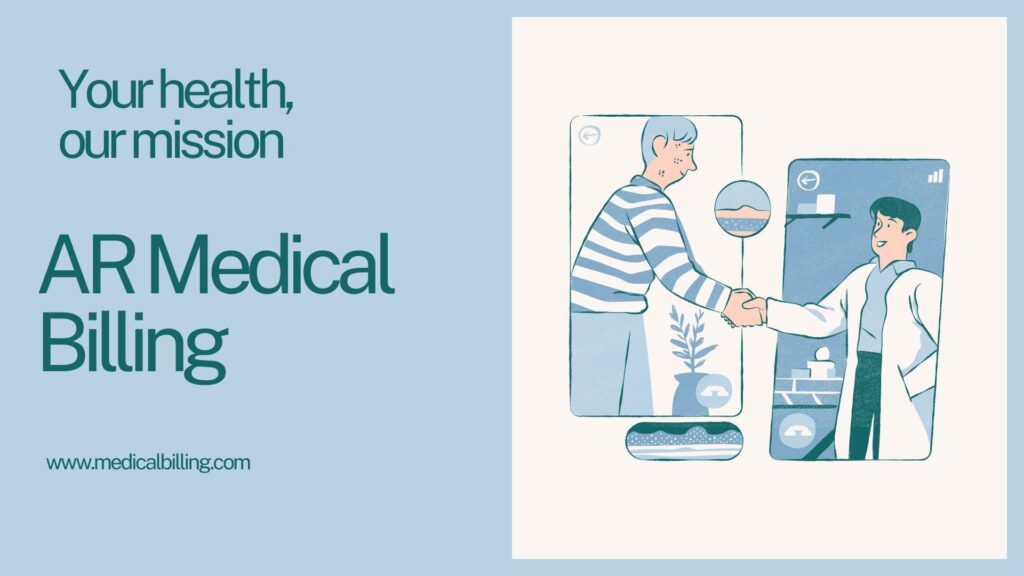Effective billing procedures are essential to keeping medical practices financially stable in the healthcare industry. One of the most important aspects of billing for healthcare is managing accounts receivable (AR).
The process of monitoring and keeping track of money owed to healthcare providers for services rendered is known as AR medical billing. Medical practices can increase their overall profitability by minimizing losses, ensuring a consistent cash flow, and using AR medical billing effectively.
What is AR Medical Billing?
The administration of unpaid balances owed by patients or insurance companies to healthcare providers is referred to as AR medical billing. These unpaid bills are frequently the consequence of co-pays, deductibles, denied or postponed claims, or other billing complications.
When a medical professional bills a patient directly or files a claim with an insurance company, the account receivable process (AR) starts and lasts until the full amount is paid.
In order to guarantee that healthcare providers are paid on time for their services, AR medical billing is essential to the financial operations of medical practices.
The Value of AR Medical Invoicing
Management of Cash Flow
Steady cash flow depends on efficient AR medical billing. In order to pay for their operational costs, which include staff salaries, medical supply costs, and equipment costs, healthcare providers depend on prompt payments. Providers may face payment delays in the absence of effective AR procedures, which could jeopardize their capacity to make ends meet.

Decrease in Rejected Claims
Dealing with rejected or denied claims presents a big obstacle for AR medical billing. Insurance companies deny denied claims when they won’t pay for services because of coding errors, missing paperwork, or other reasons. Efficient AR management guarantees accuracy during the submission process, which lowers the number of claims that are rejected.
Patient Satisfaction
Patient satisfaction can also be directly impacted by AR medical billing. The patient experience can be improved by a simplified billing procedure that reduces errors and offers transparency. Patients are more likely to pay their bills on time when they receive clear, accurate bills and are aware of their financial obligations.
Interested in exploring how automation can revolutionize your AR medical billing process?
Difficulties with AR Medical Billing
Complicated Procedures
The process of AR medical billing is intricate and involves a number of parties, including insurance companies, healthcare providers, and patients. Because every one of these organizations has different policies and guidelines, it can be difficult to understand the billing environment. Payments get denied or are delayed as a result of this complexity.
Elevated Reject Rates
As was previously mentioned, a common problem in AR medical billing is claim denials. A number of things can lead to denials, such as inaccurate coding, omitted information, or differences between the services rendered and the amount that the insurance company is willing to pay. A provider’s revenue may be negatively impacted by high denial rates, which can greatly slow down the AR process.
Insufficient Aftercare
Poor follow-up on unpaid claims is another issue with AR medical billing. To make sure that unpaid bills are collected, healthcare providers need to follow up with insurance companies and patients on a regular basis. Failing to do so may result in a backlog of unpaid claims that puts financial strain on the provider.
Modifying the Rules
The healthcare sector is always changing, as evidenced by the frequent introduction of new billing codes and regulations. Keeping abreast of these modifications is essential for efficient AR medical billing. Current regulations must be followed in order to avoid denial of claims and possible legal problems.
Common AR Medical Billing Challenges and Solutions :
| Challenges Solutions |
| Complex billing procedures Automating the billing process |
| High denial rates Proactive denial management |
| Inadequate follow-up Outsourcing AR billing |
| Changing regulations Staff training and education |
| Delayed payments Consistent follow-up procedures |
| Coding errors AI-driven error detection tools |
Important Techniques to Enhance AR Medical Billing
Streamlining the Billing Procedure
Automating the procedure is among the best ways to enhance AR medical billing. Specialized software programs that automate claim submission, payment tracking, and follow-ups are becoming increasingly popular among healthcare providers. Automation lowers the possibility of human error, expedites the billing cycle, and enhances claim accuracy.
Instruction and Training
Another crucial tactic is to fund the education and training of billing personnel. Keeping staff members up to date on the most recent billing codes, rules, and practices can help cut down on the amount of rejected claims. Frequent training sessions increase the overall effectiveness of the AR process and assist staff in staying current with industry changes.

Contracting Out Medical Billing for AR
Certain healthcare providers opt to contract with outside firms that specialize in medical billing and coding to handle their AR medical billing. Because it frees up providers to concentrate on patient care while professionals manage the intricacies of the billing process, outsourcing can be an affordable option.
The advanced tools and resources that outsourced billing services frequently have access to can improve the effectiveness of AR management.
Preventive Denial of Service
A healthy AR system requires proactive management of denied claims. This entails figuring out the underlying reasons why claims are denied and putting corrective measures in place to stop it from happening again.
It is recommended that providers create a specialized team or utilize software designed to quickly track and address denied claims.
Elements of Medical Billing in AR
It’s critical to dissect AR medical billing’s fundamental elements in order to comprehend it better. These elements consist of:
Verification of Insurance
It’s crucial to confirm a patient’s insurance coverage prior to providing care. Insurance verification guarantees that the provider files claims accurately and assists in identifying the services that are covered.
Want to learn more about the essential components of effective AR medical billing?
Submission of a Claim
After the medical professional provides the required care, the patient’s insurance company must be notified of the claim. At this point, accurate documentation and coding are crucial to guaranteeing a trouble-free claim processing process.
Posting of Payments
The insurance provider receives payment or an explanation of benefits (EOB) from the insurance company following the claim’s processing.
Management of Denies
When a claim is rejected, the denial management procedure starts. In order to guarantee that the provider gets paid, this entails going over the reasons for the denial and making the required adjustments or appeals.
Invoice for Patients
The provider must charge the patient the remaining amount if the insurance company does not pay the full cost of the services. In order to prevent miscommunication and payment delays, this step necessitates openness and concise communication with the patient.
Collections and Follow-Up
Taking care of unpaid claims or patient balances is the last step in the AR medical billing process. Effective collection of delinquent payments requires healthcare providers to set up standardized follow-up protocols.
The Role of Technology in AR Medical Billing
Automation, data analytics, and artificial intelligence are some of the ways that technology is changing the AR medical billing environment. Healthcare providers are benefiting from these advancements by increasing overall billing process quality, decreasing errors, and increasing efficiency.
Software for Billing
Numerous components of AR medical billing, such as claim submission, follow-ups, and payment tracking, are automated by specialized billing software. By streamlining the billing procedure, these tools help providers better manage their accounts receivable.
Analytical Data
Finding patterns and opportunities for enhancement in the AR process is made possible in large part by data analytics. Providers can optimize their billing strategies by making well-informed decisions based on the analysis of payment patterns and denial rates.
AI, or artificial intelligence
AI is being used more and more in AR medical billing to identify claim errors, forecast the likelihood of a denial, and automate follow-up procedures. AI-driven technologies have the potential to increase billing cycle speed and accuracy, which will accelerate payments and decrease AR aging.
In summary
AR medical billing is an essential component of healthcare administration that calls for consistency, modern technology, and close attention to detail. Healthcare providers can greatly enhance their AR management procedures by studying the obstacles and putting strategies like automation, outsourcing, and employee training into practice.
The future of AR medical billing will be greatly influenced by technology, particularly automation and artificial intelligence. As the healthcare sector develops, staying abreast of legislative changes and making use of cutting-edge technologies will be essential for billing.
FAQs
In what ways can medical providers enhance AR medical billing?
By automating the billing process, routinely training employees, handling denied claims pro-actively, and utilizing AI technology to identify errors and optimize workflows, providers can enhance AR medical billing.
How does technology fit into the medical billing process for AR?
In order to automate processes like claim submission, payment tracking, and unpaid claim follow-up, technology is essential. AI, data analytics, and billing software are examples of tools that help speed up payments and minimize errors.
What is the effect of AR medical billing on patient satisfaction?
To ensure transparency and reduce billing errors, a medical practice should have a well-organized AR billing process. Patients are more satisfied overall and are more likely to make on-time payments when they receive clear, accurate bills and have a better understanding of their financial obligations.

